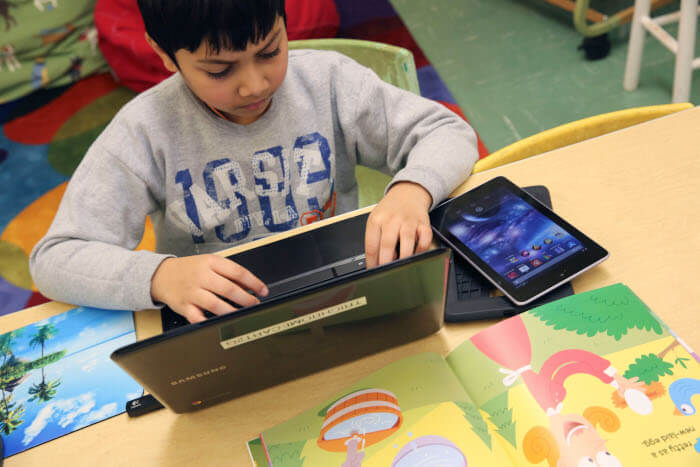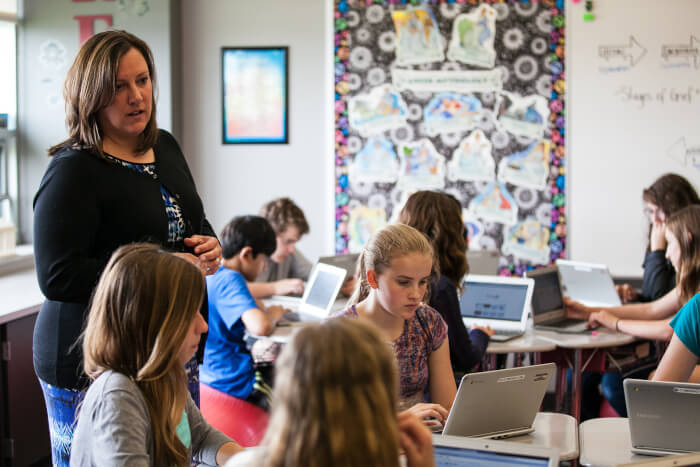Remember back-to-school preparations? Every year, parents herd their children into stores with supply lists in hand. Ruler? Check. Pens and pencils? Check. Loose-leaf paper and notebooks? Check and check.
Nowadays, technology is topping the list of supplies. As a powerful learning tool, there are plenty of reasons for students use tech devices in school.
Whether students bring their own devices or use those provided by the school, technology is integral to the learning experience. These five reasons will make you a fan of including technology in school.
Need help with technology integration? Get students to care for and about their devices.
What are the benefits of using technology in school?

1. Personalization is everything
Enroll 25 students in any class, and one thing will always be true, no two students will be at the exact same point in the learning continuum.
In the past, teachers taught “down the middle,” hoping to reach everyone. Thankfully, individualized learning has replaced that outdated approach. Students learn the same curriculum, but teachers can tailor the access and delivery to the needs of each child.
Software customizes learning experiences. It enables students to progress at their own pace while still meeting deadlines. Adaptive software assesses student knowledge, teaches essential skills, and gauges readiness for the next lesson.
Technology personalizes learning in ways that even experienced teachers can’t. Online learning is the versatile assistant that teachers and students need in the classroom.

2. Many students today have grown up with technology
Young learners have never been without the internet or mobile devices, and using them is second nature. Students have access to smartphones, tablets, and even personal laptops that they find engaging. When students aren’t in school, they’re using their devices to interact with friends and learn new things.
Teens want to meet at a new coffee shop on Saturday morning? Not a problem — Google Maps will pinpoint the location and tell them how long it takes to get there. Is the elephant-refined Black Ivory Coffee really worth the expense? Google will have the answer in .057 seconds. Upon ordering a cup, the teens share their first taste of the brew via Instagram.
The technology skills students use beyond your class are transferable to an academic setting. The same geocaching, research, and communication talents students use in the coffee shop work in the classroom when studying geography, looking up information, or expressing themselves in writing.
Savvy teachers understand that technology does not exist in isolation outside of school, it’s an instrument for learning in school.
According to a 2018 edtech survey, more than 95 percent of teachers favor using technology in the classroom, even though school funding limits adoption. Two-thirds of teachers agree that a bring-your-own-device (BYOD) policy would help put tech into the hands of all students.
Like a pencil or protractor, technology is simply another tool to help students do their work. Students bring the device best suited to their needs, and the school provides the Wi-Fi and extra technology for those who don’t have their own.
BYOD policies that provide devices for students who might not be able to afford them can bridge the edtech gap by ensuring that everyone has access.

3. Technology helps students develop better behavior
Using technology in school brings the focus back to instruction. In the past, teachers stopped class to record tardies and absences. Doing so took away from instruction. Now students can check themselves into class, freeing up the teacher. Attendance software, like the one in use at Florida’s Marion County Public Schools, streamlines the process.
Moreover, students who are engaged in learning rarely act out, but it can happen. Even your best-behaved students may find themselves bored in class. It’s not the lesson — it’s that they’re ahead of their peers, waiting for everyone else to catch up.
Technology can cut the wait time by allowing students to work ahead or explore subjects in depth. Additionally, gamification makes learning more relevant and engaging, especially when students team up with their peers.
Incorporating technology into schools means less off-task behavior and more engaged learning.

4. Workload reduction benefits everyone
Teachers work hard, to say the least — the hours they put in extend far beyond a 40-hour work week. They spend much of their time writing lessons, gathering materials, and analyzing student performance data. Then, of course, there’s the grading!
Technology is not just for students — it can also benefit teachers. All that paperwork leaves little time to do the job they love best: teaching. The right technology can transform an instructor’s day and give hours back to them at the end of the week.
Automating a teacher’s workload can help schools reap cost and time savings. And there are several ways to streamline your current process:
- Embrace learning management systems. A learning management system (LMS) is a convenient online platform for grades, lessons, discussions, feedback, and even data analysis.
- Ask for interoperability. The best technology systems talk to each other. Imagine having one login for all your classroom apps. Your students also can have a single sign-on. That way, you no longer have to look up all the logins and passwords you’ve written down for everyone.
- Broadcast yourself. If you have a mini-lesson that you’ll know you’ll repeat, create a video of it. Absent students and those needing to hear the lesson a second (or third) time have immediate access to the best of your work.
Using the right amount of technology in class can simplify a teacher’s day, giving them more time with students and saving the school money in the long run.

5. Technology is the future — don’t fall behind
Technology is almost in its fifth generation, and that means some big changes are coming to classrooms. Speculation about what’s in store includes holographic imaging, improved virtual field trips, and intercontinental studies. If you’re not currently using technology to enhance the classroom experience, you’ll feel left out when 5G technology takes over schools.
Even worse, your students won’t acquire the academic technology skills needed for success beyond school. As a McGraw-Hill survey of more than 3,300 U.S. college students (2016) points out, 84 percent believe that technology improves their education, and 81 percent are convinced it helps them get better grades. So if you want to prepare your students for a successful future in college, it’s in your best interest to adopt technology early and often.
Embracing technology in education is the only way forward
Integrating technology in schools ignites student learning and improves their capacity for teaching. Love it or hate it, technology is here to stay — and that’s all the more reason to embrace its inclusion in your school.
Technology Integration


